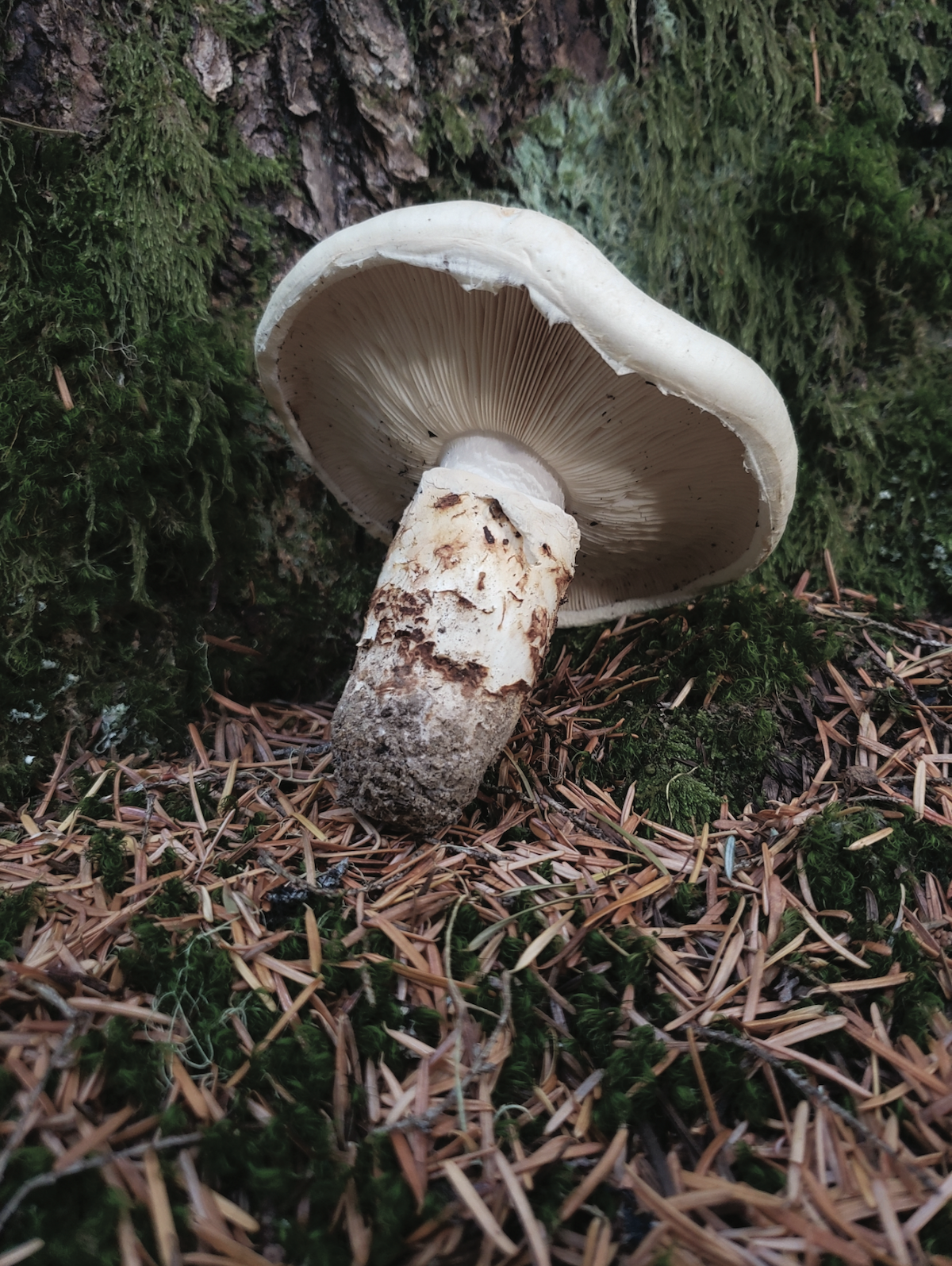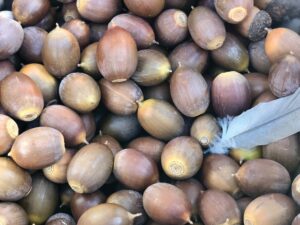I was huddled into my coat on the school bus, watching the evergreens swaying through a low fog, heading to my high school on the Hoopa Valley Indian Reservation, when I first clocked the mushroom buyers setting up shop. They’d erected a pop-up canopy. Their signs promised big cash money—for buttons, especially—and I felt the uneasiness of change. Even at 13, I understood how greed and extraction could hurt my community.

Meet Tricholoma murrillianum, a many-named mushroom: matsutake, tanoak, pine mushroom—and, to the Karuk people, xayviish. (Lindsay via iNaturalist, CC-BY-NC)
Matsutake mushroom shortages in Japan sent desperate buyers from across the sea, with pockets full of cash, to the forests of Northern California and Oregon that—thanks to Indigenous stewardship—were teeming with mushrooms. By the early 1990s, in my community, we saw hordes of foragers pouring onto Native lands to gather our traditional foods, free to roam at a time when Native gathering was often criminalized.
I’m a Karuk tribal member, and the center of the world lies on our traditional lands at the confluence of the Klamath and Salmon rivers. Our word for the matsutake mushroom (aka tanoak or pine mushroom, and scientifically classified as Tricholoma murrillianum) is xayviish, pronounced at the back of the throat: hi-weesh. In that wide and wild country, Karuk, Hupa, Yurok, and Klamath subsistence gatherers still tend the forests and gather these little relatives.
At first glance, xayviish is a humble, unassuming little guy—a dirty-looking whitish bump, hiding in the duff under healthy conifers (or even in sand dunes, like in southern Oregon). It is fragrant with the smell of pine and earth—bright and astringently herbal, velvety but firm. Xayviish has far more personality than any grocery-store mushroom. It’s a meaty but delicate time machine, whisking your spirit back to your gathering place, imprinting relationship into your heart. Now, after extractive logging practices; overharvesting by recreational and commercial foragers—some of whom rake the forest floor; loss of habitat to blights and beetles; and elongated droughts due to climate change, xayviish are harder to find, in my experience. But they are still out there.
Practice reciprocity
Gathering in a good way ensures that our communities can be in relationship with xayviish many generations into the future. A gatherer cultivates a relationship with the land, before grabbing the snacks. Foragers should embrace this practice of radical reciprocity, giving as much as they receive. If you’re unsure how to start, before you commodify these little relatives, find out on whose land you’re foraging. If you’re more expert, offer free classes to Indigenous people reclaiming land knowledge; ask if there are elders who would like to share in your harvest. And if you’re asked to avoid gathering a particular food, honor the request. Overall, be a good settler neighbor. I know foragers who have gathered thousands of pounds of mushrooms and never shared with a single Native person. It’s long past time to change these extractive practices.
These littlest of relatives form symbiotic relationships with trees, and they often coexist with other mushrooms. Finding sugarstick (Allotropa virgata), a red wildflower that lacks chlorophyll, is a sure sign that you’ve hit pay dirt. Sugarstick feeds on xayviish specifically—like a barber pole in the forest, pointing you to exactly the right place. Gently brush away the detritus from nearly invisible mounds to reveal a creamy white cap. Xayviish has bright, clean, densely packed gills and a tapering stipe with a frilly skirt blown upward. It sometimes forms small nests of fruiting bodies, or it may appear as a solitary spirit, a single periscope for the mycelium network below ground. When gathering xayviish, choose only mushrooms with fully open veils; they’ve had a chance to send out reproductive spores.
Here in the Bay Area where I live now, Marin Mycological Society founder and president Kevin Sadlier tells me these mushrooms are prolific in Sonoma County and can also be found in the Soquel Demonstration Forest near Santa Cruz, on Mount Tam, and in the Sierra Nevada foothills. Sadlier recommends looking for the telltale “shrumps” in places “with good canopy, and a really good leaf litter to keep moisture in the soil.”
Karuk people watch the deer pawing at the ground, tossing xayviish up from their underground lairs, and know what the deer know: that xayviish are an especially delicious relative. The tanoak mushroom has long benefited from basket weavers and gatherers, who lay fire to the land to reduce surface fuels and prevent high-severity wildfires. This ensures mycelium networks underneath the soil remain intact. As we all learn, or relearn, how to do this holistic stewardship work, we reap the benefit of having such a unique ingredient in the kitchen. These pine-scented little relatives and the battle against their overharvesting are a spicy reminder of the importance of centering Indigenous stewardship practices and traditional ecological knowledge.
RECIPE
Mushrooms and Mussels on Acorn Bread

At this page, find my instructions—excerpted from my cookbook Chími Nu’am: Native California Foodways for the Contemporary Kitchen—on how to make your own acorn flour and bread. And sub in another rustic brown bread if you aren’t ready for that yet.
Ingredients
1 lb. mussels, cleaned and rinsed (if any shells are open even a bit, don’t use them)
2 T butter, plus more for serving
2 cups mushrooms, cleaned and sliced into bite-size pieces
4–5 fresh thyme sprigs, plus 1 T fresh thyme leaves removed from stems
Acorn bread, for serving
Mustard, for serving
Salt to taste
Instructions
In a large saucepan with a lid, bring 2 cups of water to a boil over high heat. Add the mussels, cover, and cook for 3 to 4 minutes, until all the mussels have popped open. Toss any mussels that haven’t opened.
Using a skimmer or slotted spoon, remove the mussels from the broth and set aside to cool. Continue boiling the water to reduce by half, then pour it into a separate bowl.
Scoop the mussels from their shells and add them to the broth bowl.
Heat the butter in the same pan over medium heat, and add the mushrooms and thyme sprigs, sautéing until the mushrooms are just golden brown, 3 to 5 minutes.
Pour in the broth and mussels and sauté for 3 to 5 more minutes, allowing the liquid to reduce a bit more.
Toast a slice of acorn bread, spread some butter and mustard on it, add your mussels and mushrooms, and top with fresh thyme leaves.
This recipe is excerpted from Chími Nu’am: Native California Foodways for the Contemporary Kitchen by Sara Calvosa Olson. Reprinted with permission from Heyday © 2023.




-300x202.jpg)